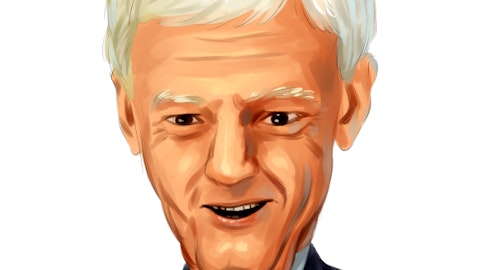And so we feel really good about the guidance range and hopefully being able to do what we’ve done all year, which is give a guidance range and then come in and be able to exceed it and kind of raise guidance, although since it’s the fourth quarter, the last part of that isn’t applicable. But I think we want to provide something that we feel very certain about and then hopefully be able to over deliver on expectations.
Chris Kennedy: Yes, thank you for that. Very helpful. And then just a follow-up on Primaloft. I think you talked about softer demand there. Can you just give us a reminder on kind of the visibility of that business and when we should start to see bookings improve or whatnot?
Pat Maciariello: Yes, so we’re starting to book now for fall, winter of 2024 for the most part. And so that’s where I was saying that a lot of the brands are cautious. If you read, I won’t name the names, but if you read some of the big brands’ discussions, they’re cautious about what the first half of 2024 is going to look like. That obviously flows through to how they order. And so our hope is that what we’re going to do is see later orders and kind of see that order book build later over time, but we’re just not there yet in the fall, winter, 24 booking cycle.
Chris Kennedy: Got it. Thanks for taking the questions.
Pat Maciariello: Thank you, Chris.
Operator: [Operator Instructions] Your next question comes from the line of Barry Haimes from Sage Asset Management. Your line is now open.
Barry Haimes: Thanks so much. Congrats on the quarter. I had two questions. One is getting back to the inventory de-stocked, primarily in consumer. If next year you got to a point where selling and sell-through matched, what sort of range of incremental revenues would you get next year? Or is that another way? How much were revenues per this year by the fact that selling was less than sell-through? And then my second question is, on Lugano, realizing that each location is a little different, could you give us just sort of a rough range to stand up a new location between CapEx and working capital? What kind of range per location we’re talking about? Thank you.
Elias Sabo: Sure. And thank you for the question. So in terms of kind of inventory de-stocking, it’s impossible to tell because we don’t get from our consumers exactly what their sell-through is and what their sell-in is. I can tell you anecdotally, for Primaloft, for example, one of their customers we talked to, as Pat said, we don’t name names of customers, but we talked to a person who’s handling the general management of that product, and they said, yes, we expect to be up double digits with it, and we talked to the purchasing department, and they said, yes, your sales are going to be down 20%, your orders. So that would kind of correlate to call it a 30% plus or minus inventory contraction that is kind of net cost of inventory contraction to our revenues this year.
I think probably I would say between 20% and 40% seems about right. I give you one other anecdotal piece of evidence. One of our own companies, which is farther up the supply chain, we asked our CEO what our purchase orders right now relative to what they would normally be to the factory, and believe it or not, they’re down about 50%. And so I think it’s going to vary by company and to further the point of how long do you think until we’re reverting back to normal orders to our factory, and the response was we’ll probably be back to open to normal by mid next year. So that means orders will start getting to those factories 90 to 120 days in advance. So in this particular company, we’re probably looking at year end when we start to open up orders to a more normalized basis.
So I think it’s impossible to tell. I would be absolutely stunned if the impact was less than 20%. And I can tell you it’s not more than 50%, but I think 20% to maybe 30% is probably if you ask for a gut instinct and a swag feels like the right number. In terms of Lugano, I’ll let Pat answer that.
Pat Maciariello: I mean, there’s a broad range based on the store. It can be from four to 10 million or plus of CapEx based on the store. And then inventory is at least the high end of that is what we stock it with and probably a little more.
Elias Sabo: So I think if you’re modeling it, I would say $15 million to $20 million of total investment that goes into the business between CapEx and inventory. And then we stand these things up and look, we expect to get very high returns on invested capital 30%, 40% types of return on that.
Barry Haimes: Great. Thank you so much. Appreciate it.
Elias Sabo: Thank you.
Operator: There are no further questions at this time. I would now like to turn the conference back over to Mr. Elias. Sir?
Elias Sabo: Thank you, operator. As always, I’d like to thank everyone again for joining us on today’s call and for your continued interest in CODI. Thank you for your support.
Operator: This concludes Compass Diversified’s conference call. Thank you and have a great day.
Follow Compass Diversified Holdings (NYSE:CODI)
Follow Compass Diversified Holdings (NYSE:CODI)
Receive real-time insider trading and news alerts



